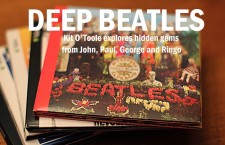One of the most heartfelt and intimate tracks on the Beatles’ White Album, “Mother Nature’s Son” draws its inspiration from three primary sources: Paul McCartney’s childhood, the Maharishi Mahesh Yogi’s teachings, and the standard “Nature Boy.” McCartney thoroughly discussed these origins in Barry Miles’ biography Many Years from Now. Childhood days spent in the countryside partially inspired the song, what he called his “child of nature-leanings.” Years later, McCartney’s time studying with the Maharishi Mahesh Yogi further encouraged him to explore the wonders of nature. Incidentally, John Lennon would write a song called “Child of Nature” also inspired by the retreat, but later transformed it into “Jealous Guy.”
As McCartney told Miles, he wrote the song after stopping by his father’s home in Liverpool. “Visiting my family I’d feel in a good mood, so it was often a good occasion to write songs,” he said. He also recalled loving the song “Nature Boy,” a tale of a young man’s enchantment with nature; apparently feeling a connection with that character, Paul McCartney composed his own version of the tune. A demo version was recorded during the “Esher” sessions at George Harrison’s Kinfauns home in May 1968; the final version deviated little from this initial attempt (except for extended double-tracked vocal harmonies in the coda). After completing the demo, McCartney would not lay down the final version for more than two months.
On August 9, McCartney entered Abbey Road studios to record his vocals and acoustic guitar simultaneously. He completed 25 takes under George Martin’s direction, with take 24 deemed best (take two later surfaced on the Anthology 3 compilation). Returning to “Mother Nature’s Son” on August 20, McCartney overdubbed timpani, another acoustic guitar part, and drums to take 24. (He played the drums in a corridor outside the studio for a deeper sound.) Next, McCartney and Martin worked on the brass arrangement for two trumpets and two trombones; the musicians completed their parts during this same session. According to engineer Ken Scott, Lennon and Ringo Starr entered the studio during the brass recording section. “You could cut the atmosphere with a knife. An instant change,” Scott told Mark Lewisohn for the Complete Beatles Recording Sessions. “It was like that for 10 minutes and then, as soon as they left, it felt great again. It was very bizarre.”
“Mother Nature’s Son” represents pure Paul McCartney in terms of lovely melody and simple arrangement. Yet there’s also an intimacy to the performance; one can picture him sitting in his father’s living room quietly strumming the tune. The opening guitar notes retain slight finger scraping and buzzing; this, along with the drums stumbling in, adds a sense of informality and imperfection. As with “Rocky Raccoon,” McCartney’s guitar-picking style reflects Donovan’s growing influence on his work. While he cites “Nature Boy” as one of his sources of inspiration, the lyrics only vaguely resemble each other. In “Nature Boy,” composer eden ahbez’s lyrics begin “There was a boy / A very strange, enchanted boy / They say he wandered very far … over land and sea.” In contrast, McCartney opens with the lines “Born a poor young country boy / Mother Nature’s son.” Immediately, however, the Beatles star clarifies that he represents the title character; conversely, ahbez’s story describes the “nature boy” only through the narrator’s reactions and conversations with the man.
Wisely, McCartney sings the words without much vocal adornment, letting the vivid images carry the song. Thinking back to his childhood days in the country, McCartney describes sitting by a mountain stream, simply watching and listening to the water. He refers to the “pretty sound of music as she flies”; later, he paints a picture of sitting in the grass, watching “swaying daisies sing a lazy song beneath the sun.” In this pastoral setting, the sights and sounds of nature become music, which presumably inspired McCartney to compose “Mother Nature’s Son.” Horns gently float beneath the surface, only becoming more prominent at the conclusion. Drums enter the stage in the middle eight, the thumping gently accenting McCartney’s scatting. The ending trumpet and trombone notes slightly descend, suggesting melancholia or a reluctance to leave this enchanted garden.
“Mother Nature’s Son,” along with other Beatles tracks such as “I Will,” represents McCartney’s gift for stripping down a song to its basic elements to lay emotions bare. He would continue this method in his solo career, with “Bluebird,” “Little Willow,” “Here Today,” and “Heart of the Country” (perhaps part two of “Mother Nature’s Son”) emerging as quintessential examples of this songwriting technique. “Yesterday” may have been one of McCartney’s earliest experiments with this method, but “Mother Nature’s Son” proves his mastery of simplicity in melody, subject, and arrangement.
- The Rescued Early Paul McCartney Song That Completed ‘Beatles For Sale’ - December 4, 2024
- A Rare Beatles Cover Proves John Lennon Was Wrong About His Voice - November 26, 2024
- How John Lennon Came Roaring Back on the Beatles’ White Album - November 22, 2023


